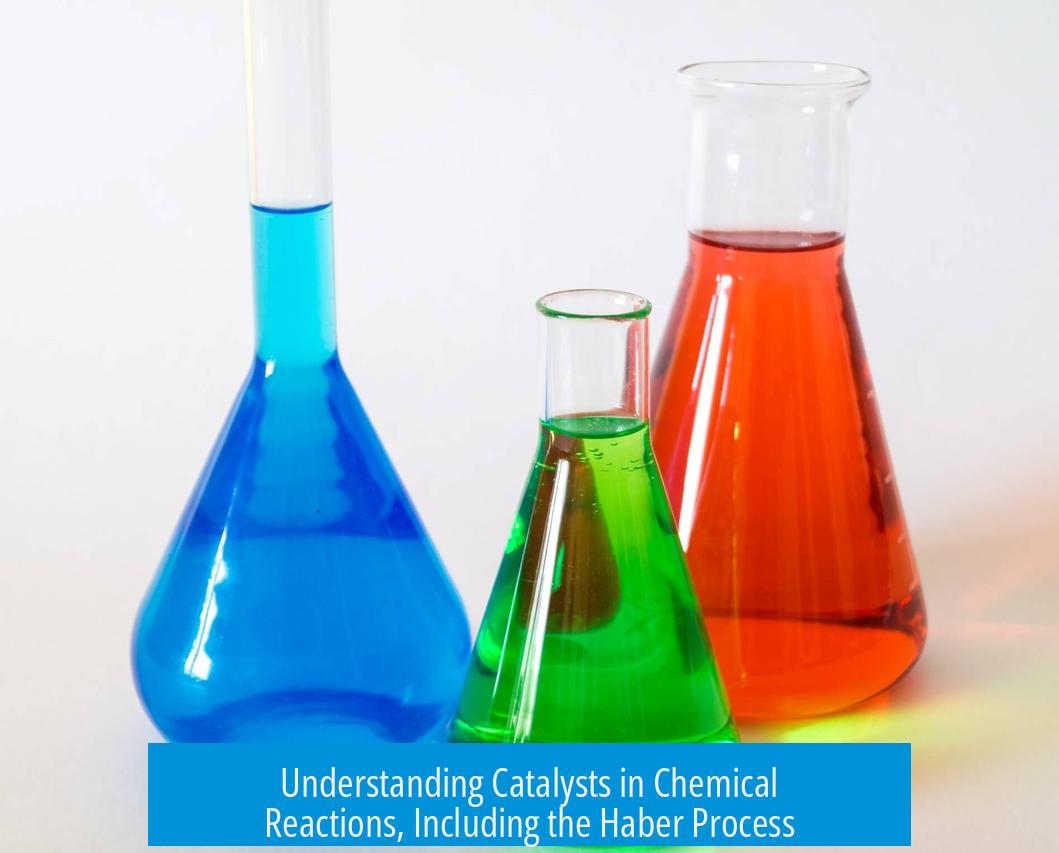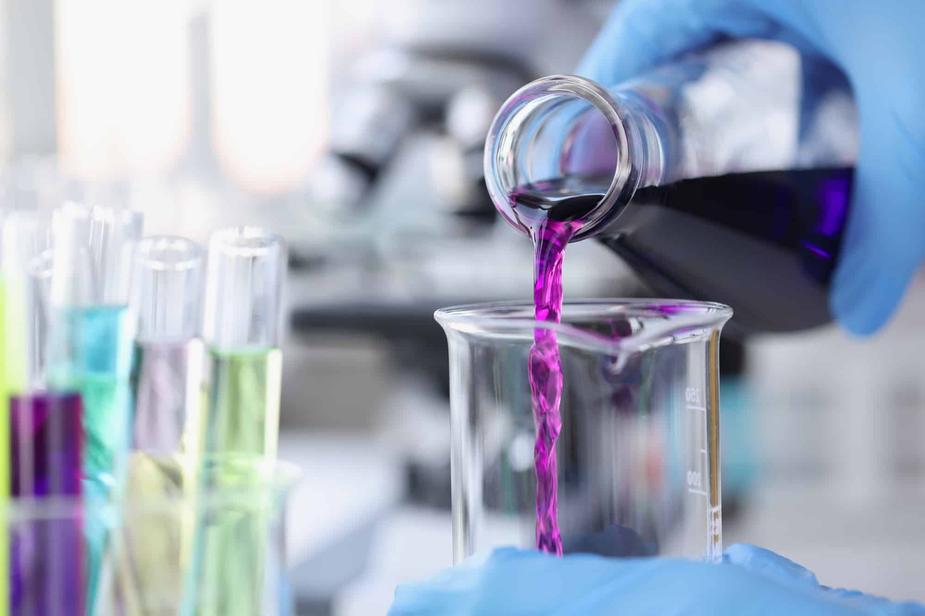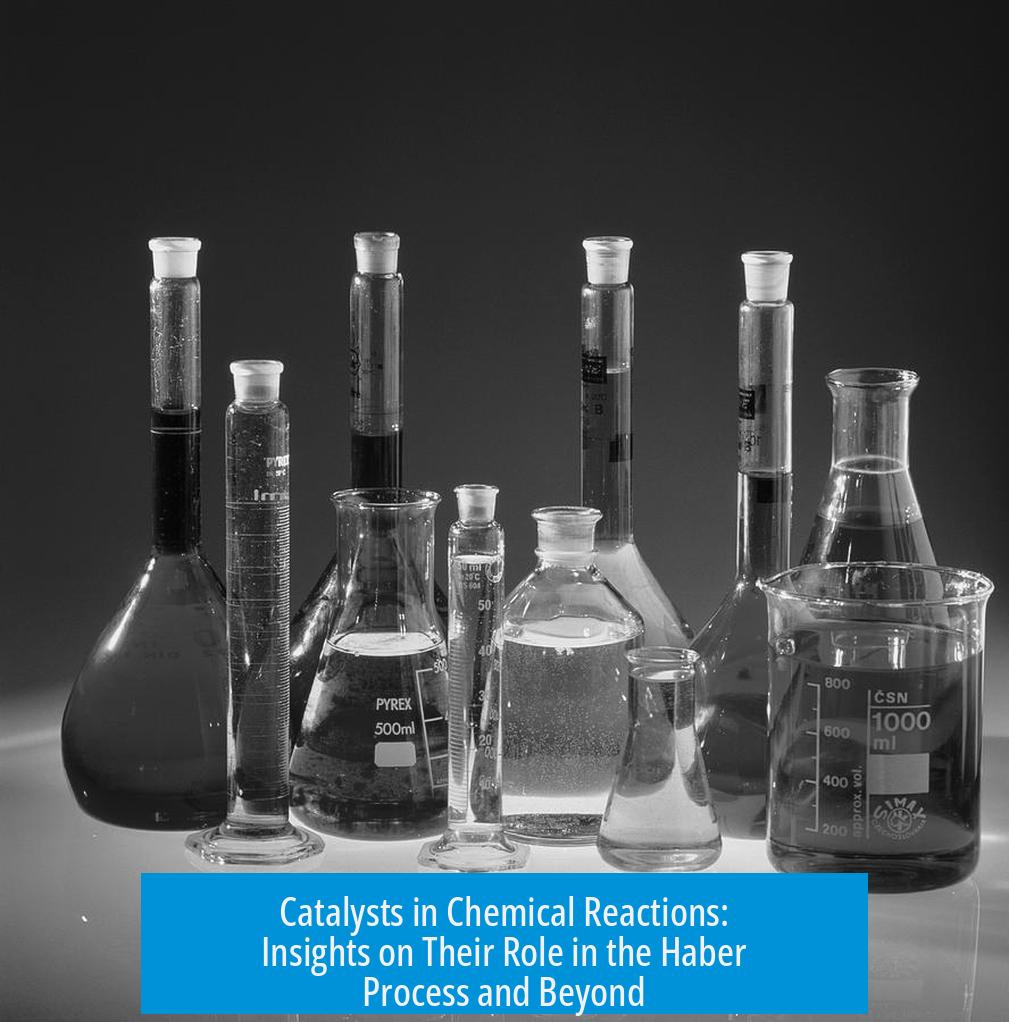Understanding Catalysts in Chemical Reactions, Including the Haber Process

Catalysts speed up chemical reactions without being consumed. They lower the energy barrier required for the reaction, allowing it to proceed faster but without changing the overall chemical equation. This principle holds true across many processes, including industrial-scale reactions like the Haber process for ammonia synthesis.
Role and Basic Function of Catalysts

Catalysts accelerate reactions by lowering activation energy. They provide an alternative reaction pathway that requires less energy. This reduces the time and energy needed for reactants to convert into products.
Importantly, catalysts do not alter the reactants or products chemically. The starting materials and end products remain the same, but the pathway to get from one to the other is made easier.
Catalyst Regeneration and Stability

During a reaction, catalysts may temporarily form intermediate compounds with reactants. However, they are regenerated at the reaction’s end and remain unchanged overall. This means catalysts can be reused multiple times.
Over prolonged use, catalysts can lose effectiveness, a process called deactivation. For instance, automotive catalytic converters maintain activity over many years but eventually degrade due to surface fouling or poisoning.
Alternative Pathways and Mechanistic Action

The key function of a catalyst is offering an alternative pathway with lower activation energy. This alternative route might involve intermediates that temporarily bind to the catalyst.
- Reactants adsorb onto the catalyst surface or active site.
- Bonds in the reactants weaken, making them more reactive.
- Second reactant molecules interact with these activated intermediates.
- Products form and desorb from the catalyst, which returns to its original state.
This sequence lowers the energy barrier and speeds the reaction while preserving catalyst integrity.
Examples: Acid Catalysis and Heterogeneous Catalysis

In acid catalysis, a proton (H+) is temporarily donated to the reactant, activating it. The proton is regenerated at the reaction end, ensuring the catalyst remains available for further cycles. Using isotopes like deuterium in these acids can help reveal the exact mechanistic steps by tracking proton incorporation.
In heterogeneous catalysis, the catalyst exists as a solid surface on which reactants adsorb and react. The Sabatier reaction is a classic example that converts CO and H2 into methane and water. Although thermodynamically favorable, this reaction proceeds slowly without a catalyst.
| Step | Description |
|---|---|
| 1 | CO and H2 adsorb on catalyst surface. |
| 2 | Catalyst cleaves H-H bond forming adsorbed H atoms. |
| 3 | H atoms diffuse to adsorbed CO, forming intermediates (COH, HCOH). |
| 4 | Catalyst facilitates bond cleavage in intermediates, creating CH and OH. |
| 5 | Continued hydrogenation steps produce methane and water, which desorb. |
The Haber Process and Catalyst Role
The Haber process synthesizes ammonia (NH3) by combining nitrogen (N2) and hydrogen (H2) gases. It uses an iron-based heterogeneous catalyst to accelerate this otherwise slow reaction.
Here’s how the catalyst functions in the Haber process:
- N2 and H2 adsorb onto the iron catalyst surface at active sites.
- The catalyst weakens the strong N≡N triple bond, enabling its cleavage.
- Adsorbed hydrogen atoms sequentially react with nitrogen atoms to form intermediates.
- Stepwise hydrogenation leads to ammonia formation.
- Ammonia molecules desorb from the surface, freeing active sites.
- The catalyst is regenerated and ready for further cycles.
This process reduces the required temperature and pressure, making ammonia production economically feasible on an industrial scale.
Addressing Common Misconceptions About Catalysts
- Catalysts are not consumed during a reaction; they are regenerated at the end.
- They do not change the stoichiometry or chemical formula of the reaction.
- Sometimes catalysts facilitate reactions by physical means, such as generating heat, rather than directly participating chemically.
- Catalysis occurs at defined active sites—specific regions on the catalyst surface or enzyme where reactants bind and transform.
Active Sites in Catalysis
Catalyst activity depends on active sites, which are locations on the catalyst that interact directly with reactants. These sites are critical in heterogeneous catalysis and biological catalysis (enzymes).
At these sites:
- Reactants adsorb and orient properly for reaction.
- Bond weakening and electron transfers occur.
- Transition states form more easily, lowering activation energy.
Understanding active sites is key to designing better catalysts and improving reaction efficiency.
Key Takeaways
- Catalysts speed reactions by lowering activation energy without being consumed.
- They provide alternate reaction pathways, often via surface adsorption or intermediate formation.
- The Haber process uses an iron catalyst to efficiently produce ammonia by breaking strong N2 bonds.
- Catalysts are regenerated after each reaction cycle but may deactivate over long periods.
- Catalysis occurs at active sites where reactants bind and interact with the catalyst surface.
- Common misconceptions include that catalysts get used up or change the reaction’s overall formula, which is not true.
Ey, What Is Up With Catalysts Used in Chemical Reactions, Like the Haber Process?
Simply put, catalysts speed up reactions by lowering the energy barrier needed, without being consumed themselves. That’s the magic trick behind catalysts in the Haber process and tons of other chemical reactions. They make things happen faster and smoother, but stay intact themselves. Let’s unpack how these fascinating agents work, their quirks, and why they’re essential for industrial chemistry.
So, why do chemists call catalysts the “unsung heroes” of many reactions? It’s because catalysts don’t start or change the main reaction but give it a shortcut, a less energy-intense pathway. Imagine you’re hiking and find a steep mountain trail. That’s the original reaction pathway—tough and energy-heavy. A catalyst acts like a secret tunnel through the mountain—making the journey easier and faster.
In the Haber process specifically, ammonia synthesis is the crown jewel of catalyst application. Without a catalyst, combining nitrogen and hydrogen gases to form ammonia would take ages. Thanks to an iron-based catalyst, this process becomes industrially feasible. The catalyst provides sites where nitrogen and hydrogen adsorb on the surface, weakening their bonds and allowing them to combine into ammonia faster. It’s like a speed dating event for molecules.
The Role and Mechanism of Catalysts: More than Just a Speed Boost
Catalysts lower the activation energy—this is the energy ‘hill’ molecules have to climb to react. They don’t change the chemicals involved or the final products; instead, they give molecules a different, easier route. This alternative path usually involves intermediates that temporarily bind to the catalyst, altering the reaction dynamics without the catalyst disappearing.
Take the example of a reactant molecule bonding with the catalyst. This bond weakens certain internal bonds within the reactant, setting it up perfectly for the next reactant to jump in and complete the reaction. Once the product forms, it separates from the catalyst, leaving the catalyst unchanged and ready for its next chore.
This binding-and-releasing dance repeats endlessly—like a chef preparing dish after dish using the same wide knife without dulling it (well, for a long time at least).
Catalysts Aren’t Consumed—Or Are They?
You might wonder, if catalysts participate so intimately, do they get used up? The answer is nope; catalysts aren’t consumed in the reaction. They come out at the end just as they entered, like party guests who leave with their jackets still on.
However, catalysts can stop working eventually. They might get poisoned by impurities, sintered due to heat, or just worn out physically. For example, car catalytic converters typically last over a decade before their efficiency drops.
Giving You an Alternative for Activation Energy
Imagine the original reaction pathway as a wildly challenging puzzle. The catalyst offers an alternative solution, cutting down the difficulty. But, the reaction doesn’t magically switch to using the catalyst’s route every single time—there’s always a chance molecules choose the old way. Yet because the catalyst lowers the activation energy, the reaction happens faster overall, making it industrially and commercially worthwhile.
Acid Catalysis: An Elegant Example
In acid catalysis, a proton (H+) may temporarily join the reaction, only to be released later, unchanged. It’s like lending a hand during a tricky dance move and then stepping back. Chemists take advantage of this by sometimes substituting protons with deuterium (heavy hydrogen) to track whether the proton ends up in the product. This helps unravel reaction mechanisms without changing the catalyst’s identity.
Heterogeneous Catalysis and the Sabatier Reaction Example
The Sabatier reaction is a cool example showing catalysts in action—turning carbon monoxide and hydrogen into methane and water:
CO + 3H2 → CH4 + H2O
Thermodynamically possible but frighteningly slow without a catalyst. The catalyst surface grabs CO and H2, breaking H-H bonds, allowing hydrogen atoms to migrate and react stepwise with adsorbed CO, forming intermediate complexes like COH and HCOH. Eventually, methane and water form and leave the surface.
In this process, the catalyst doesn’t just speed things up; it actively facilitates tiny bond breakage and formation steps, helping electrons shift in the molecular dance. Without the catalyst, this would be a lullaby instead of a fast-paced tune.
Common Misconceptions About Catalysts
One big misconception? People think catalysts might alter the chemical formula of the reaction or get “used up.” Nope. Catalysts don’t violate conservation of mass by disappearing. They won’t steal atoms or permanently stick to molecules. Their job is to lower the activation energy, not rewrite chemistry’s rulebook.
Some catalysts even help by producing heat near the reaction zone (like a campfire warming everyone up)—accelerating reaction rates without chemically transforming themselves at all.
It’s All About Active Sites
The secret sauce is the “active site” of a catalyst. For heterogeneous and enzyme catalysts alike, active sites are tiny hotspots where reactants latch on, bonds weaken or rearrange, and the magic unfolds. Think of it as the stage where molecules perform and transform.
In enzymes, these active sites are so specialized they can recognize a single molecule among many, speeding up reactions with mind-blowing precision.
Final Thoughts: Why Should You Care?
Knowing about catalysts gives you a peek into how everyday things—from fertilizer making to refining fuels, to car emissions control—work under the hood. Industrially, catalysts save energy, time, and cost. Without them, producing ammonia for fertilizers (via the Haber process) or methane for fuel (through the Sabatier reaction) would be impractical or impossible at commercial scale.
Next time you fill up your car, consider the catalytic converter working hard to clean exhaust gases. Or when you appreciate your garden’s lush growth, remember that ammonia synthesized by the Haber process (helped by catalysts) made those fertilizers possible.
If you ever wondered why some reactions crawl while others race, it mostly boils down to catalysts and their clever energy-lowering tricks.
To sum it up: catalysts offer alternative reaction pathways with lower activation energy, temporarily hold reactants to weaken bonds, help bond-breaking and reforming, then regenerate themselves. Their surface “active sites” are where the action happens. Whether in the Haber process, Sabatier reaction, or everyday acid catalysis, they make chemical magic faster and feasible. And, importantly, they stick around for repeated use until wearing out—a true workhorse in the chemist’s toolkit.
So, next time you hear “catalyst,” imagine a molecular matchmaker or coach, who hustles molecules to dance faster, without ever getting tired.





Leave a Comment